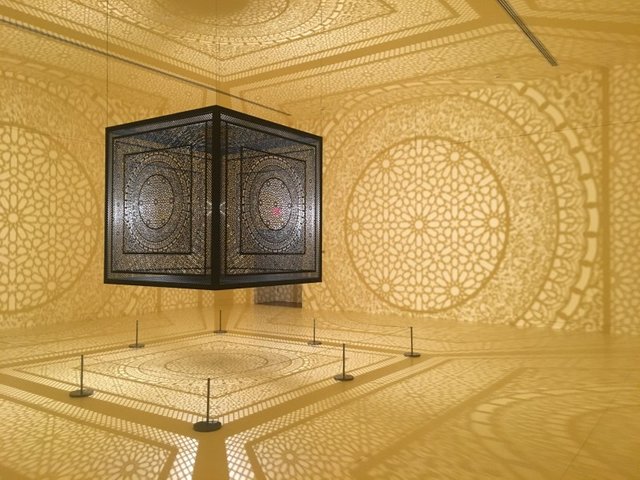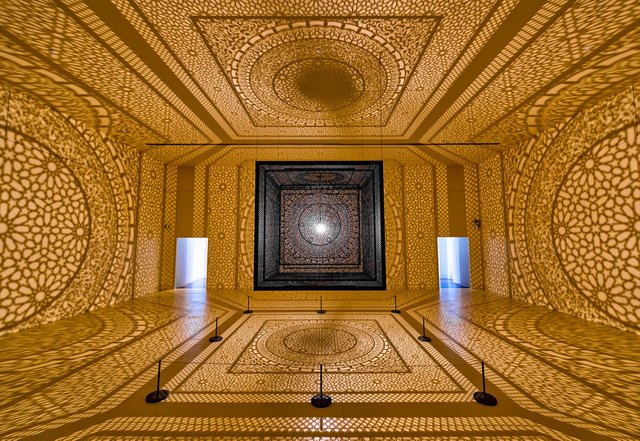Art and Neuroscience - Finally They Met
This morning I received this spectacular image!...
Well at least, I find it spectacular, although I may not be so fond of yellow gold.
I hope you agree with me?! I mean regarding the 'spectacular' part, not necessarily the yellow gold part :)

I dug around a little and found out this photo is from a room in the Peabody Essex Museum in Salem Massachusetts USA (http://pem.org/exhibitions/193-intersections_anila_quayyum_agha).
What is interesting of the approach PEM is taking for its exhibitions is the fact they have a full time neuroscientist working with them to support creating the exhibitions to help to elevate art and creative expressions. PEM is the first museum in the world who created such position.
You would think: Why such science in an art museum?
It is build upon a extremely simple thought and experiences we already know with for instance fine dining: the experience of food is not only the taste of the food, but also the texture, the ambiance we sit in, the company we are with etc etc. Why not bring such cross senses experience into the experience of art, right into the museums?
“One day, this very, very simple thought struck me that all art museums create art experiences—that’s what an exhibition is, that’s what programs are—and all of our experiences are created in our brains,” he explains. “Obviously, there’s a world out there, but we’re taking in information from that world, and then it’s interpreted and processed.
Of course, a lot of art forms exists and are experimented with. Recently I was at a electronic music event in Paradiso Amsterdam where not only a DJ and VJ were doing their thing (video here), but also someone who created different smells on the spot and blew them (with the support of a big fan) over the dance floor to touch other senses we have than our ears and eyes only.
How cool is it when we can get these type of experiences in a museums? Instead of watching and sometimes hearing things, we may get smells added to the mix? I certainly hope with the decision PEM took to hire a neuroscientist, we will start seeing more museums following their example.
“If you’re actually committed to trying to create experiences of art that are as compelling and meaningful and as rich as possible, it would be a good idea to better understand how brains work,” Monroe continues. “It’s such a basic obvious idea, I’m astounded that it never struck me before.”
With neuroscientists working in places where art is displayed, we may get a whole different experience, since when we know how are brains are reacting on a certain display of art, we can adjust the display of art to create maximum impact.
And it is that impact we like so much; It is that impact that will keep us to want more.
Neuroscience ideas can inform the arts in different ways, Asher says. She’s mulling over what she calls “bottom-up” approaches, based on the structures and functions of biological systems, as well as “top-down” avenues focusing more on cognitive and emotional processes that influence experiences and decision-making. For example, she says, “if you’re looking at a painting, you might be struck by contrasting color or shading,” and at the same time by “your own personal past experiences and what associations that causes you to have with what’s depicted in the painting.”
Another study had participants listen to music while an fMRI scanner showed that brain activity dramatically increased during rests in the composition, firing with the expectation of what would come next. The same concept applies to the visual system, Asher says, so a museum might want to offer visitors a “visual palate cleanser” and “space to decompress” to help them savor an upcoming piece of art.
NJOY!

--- follow me @edje
thanks , very interesting post! I follow you
Thanks :)
Wow!
WOOHOO :)
This is a very interesting concept. Like the museum curator states, such a simple idea, I wonder we never thought of it before. Stepping into that room would be an experience indeed.
Maybe because museums are to traditional to think of other senses of the human. And science is too beta and therefore to far away from art?
Now in the digital age, art and technology coming more closer.
Also, only recently we can better understand/measure brains activities; also for that technology was needed that wasn't available years ago.
Very true, our technology has come a long way. The traditional sense of science being so different from art is unfortunate. As we well know, all humans are made up of different likes and preferences and the idea that art and science are different is wrong. I have a good friend who is a biologist, but she also sells the pictures she takes of cells under a microscope to an art gallery.
I fully understand why she is selling cells as art. Lot of 'science' stuff can be art! Kaleidoscopes; Fractals; The Golden Ratio. The later I find fascinating; We see it everywhere; Just earlier today I wrote an article about it, well kind of... https://steemit.com/trading/@edje/nature-biology-art-fibonacci-is-everywhere-also-in-trading
This is interesting. Lovely share @edje
Thanks :) Followed as well :)
Excelent, topic.
I thought so indeed :) Thank YOU!
I go to this small museum often as I live nearby, the exhibits are great. Here are two Exhibits from there that I posted here (not as cool as the one you are reporting):
https://steemit.com/art/@kyusho/wow
https://steemit.com/art/@kyusho/da-da-vinci-day
WOW, cool! You are at the right museum, I really like their innovation to think in new ways how to make museum's more attractive, also to the new generation!.
Did you also see the Dutch VOC exhibition? I'm from Holland (aka The Netherlands) and the VOC (East India Company in English) was THEY engine to prosperity of many people in Holland since this private company financed their trading with Asia back in 17th century with money from many many people living in the country, all small loans and shareholders. VOC did VERY well and that is why the 17th century is also called the Golden Age. With the VOC doing very well, all these Dutch people who gave loans and investments did also very well. Amsterdam, was developed for a large part due to the VOC's success as well. I was pleased to see this museum done a exhibition about this! :)
They always have in their collection objects of the East India Company as Salem,MA was an important port for them. In fact the small mall across from them is called "East India Mall"
Super! When I'm kind of in the neighbourhood, I really need to come and visit the museum!
Check the exhibit first.
Stunning and very intriguing image 🙀 I never heard of this museum before
Didn't hear of this museum as well, but I find them SUPER COOL! :) Next time I'm in the USA, East Coast, MA, then I really really like to go their. Oh well, I giess it is not super far away from NYC, so I should allow myself a trip to the big apple and then I can swing by PEM. Last year they did an exhibition about the VOC, the Dutch East Indie Company, considered the first globalised company in the world and it did build Amsterdam and made the Dutch rich. Ah, maybe I shall write an article about that :)